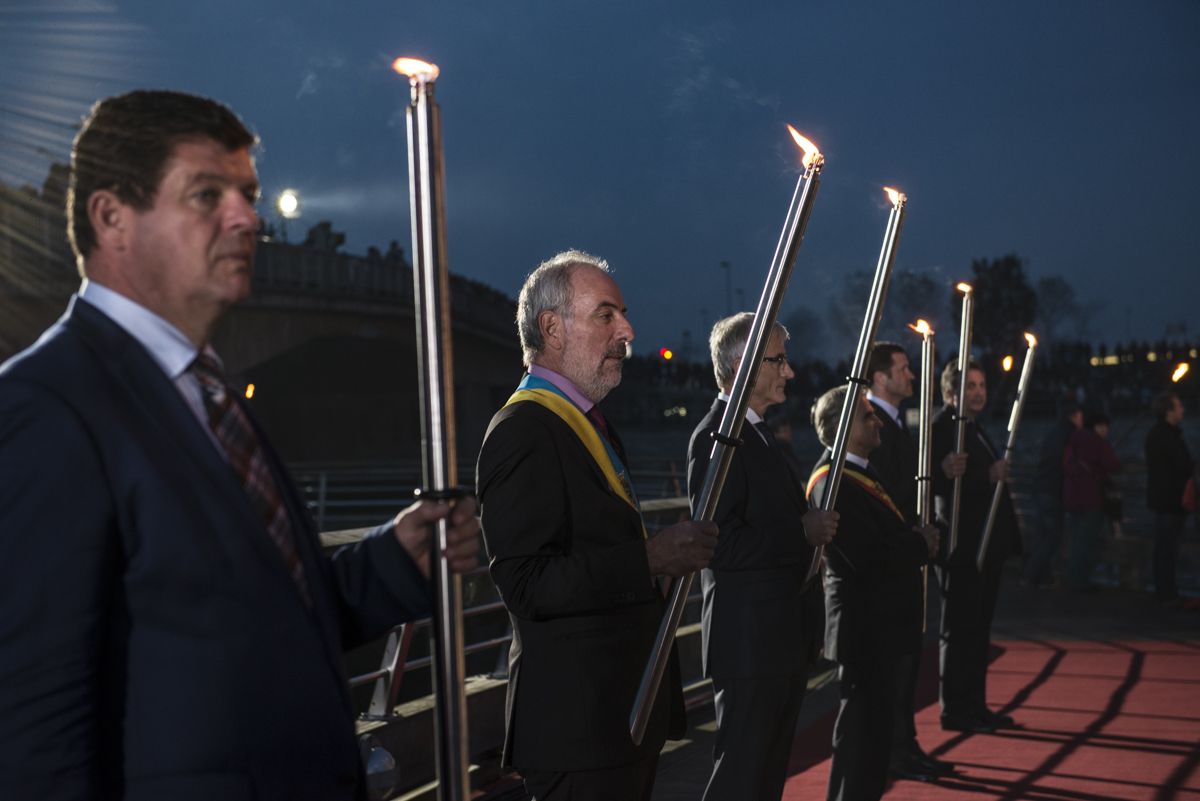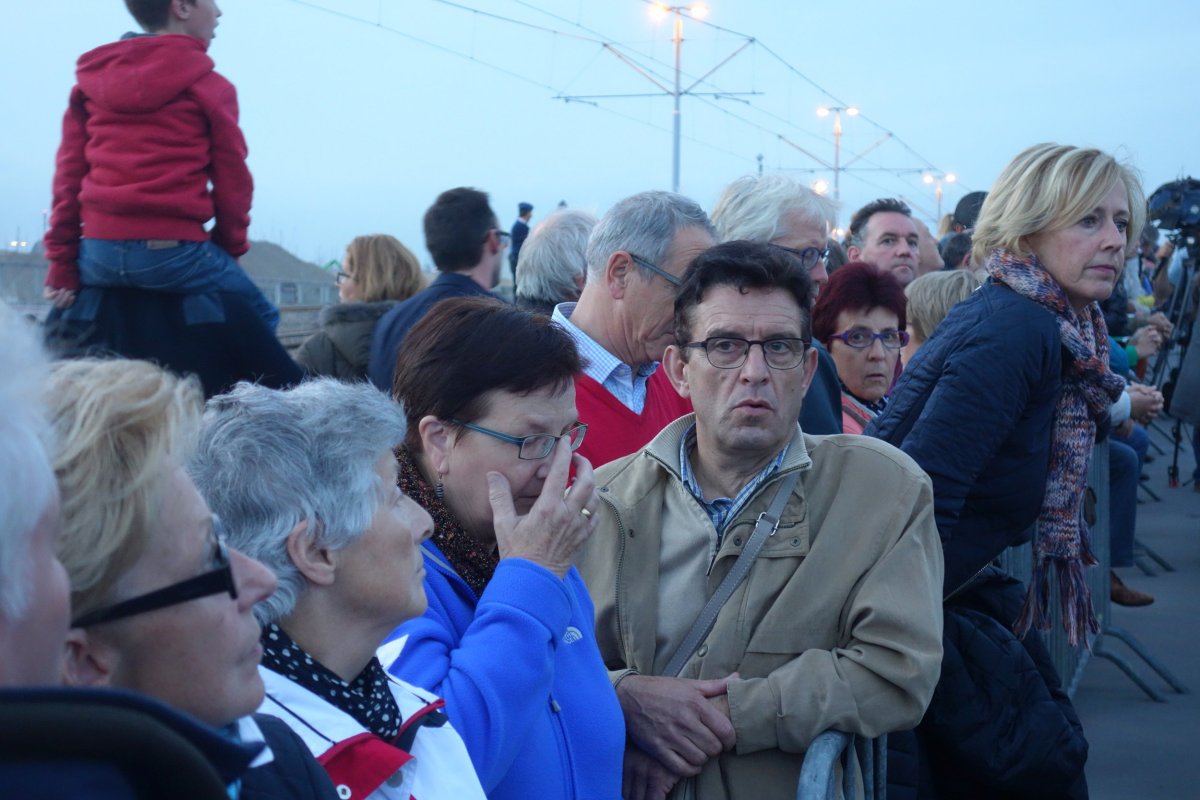
On a mid-October night, thousands of flaming torches lit up the countryside in the Belgian region of Flanders. There were 8,400 torchbearers wielding them, and they formed a human chain more than 80 kilometers long, stretching from the village of Ploegsteert along the French border to the coastal city of Nieuwpoort. There, as throngs of spectators stood in anticipation, the names of hundreds of thousands of World War I casualties could be seen projected onto the city's massive, circular Albert I monument. Far below, a show of sparks flickered and died out in the Yser River.
Known as Lichtfront '14 (or "Light Front '14"), the interactive event marked the provincial government's most extravagant tribute to the centennial of a war that changed the world—and began in this particular region. During Lichtfront, the human chain of torchbearers followed the front line of the war as it existed in late 1914, when soldiers were said to look out at night and spot each other's lights across the Belgian Front.
The scene here a hundred years ago was not so picturesque. The Rape of Belgium—as historians have come to call the horrific outbreak of rape, murder, looting and burning that German occupiers inflicted on the then-neutral nation—had just begun. In October and November of 1914, the First Battle of Ypres dragged on and put the Allied armies on the defensive. As many as 6,500 French and Belgian civilians were killed by the German army during that occupation. Four years later, an International Committee of the Red Cross appeal would sum up the atrocities by protesting a type of "warfare that we cannot call anything but criminal."
No one in Flanders is old enough to remember the Great War (the last veteran of the war, an Englishwoman, died in 2012), but no one seems quite able to forget, either. Traces of that trauma infuse the region's landscape, museums, literature and stories. On a recent press tour of the region, it emerged anew in Nieuwpoort, where an art organization is producing 600,000 small sculptures to represent 600,000 casualties on Belgian soil, and in the small but historic "martyr city" of Leuven, where the University Library Tower was burned but later rebuilt. It stands today as a testament to perseverance in the face of wartime destruction. The casualties in Leuven included intellectual heritage as well as human lives: Hundreds of thousands of books and manuscripts, some dating back to the medieval era, were destroyed in the assault.

"It was a terrible war," Minister-President of Flanders Geert Bourgeois told Newsweek just before the start of Lichtfront. He began planning events for the centennial as long ago as 2006, though formal planning for Lichtfront started in January of this year. "The whole area is a relic of it—there are bunkers, there are trenches. The landscape is a testimony of this war. It's our duty to maintain it."
That duty of remembrance is observed daily in Ypres, where locals observe a memorial ceremony each night, gathering at the Menin Gate Memorial for a moment of silence as buglers perform the "Last Post" call. The tradition has proceeded apace since 1928, despite a brief relocation to England during World War II.
Bourgeois's observation about the countryside is evident in the scattering of war cemeteries that unfold across the Ypres Salient area of the Western Front. They are solemn, grassy sites, their reflective air punctured only by the parades of British schoolchildren skipping their way through. The most famous of these is Tyne Cot, a sprawling British burial ground that counts several notable army captains among its dead, though the more moving section is the "Memorial to the Missing," for fallen soldiers "whose graves are known only unto God." It is the world's largest British military cemetery. Nearby is the American counterpart: the Flanders Field American Cemetery and Memorial. There, a superintendent named Chris Arseneault stands guard over the American dead.
"When our great-great-great grandkids come, they should see exactly what we see now," said Arseneault, a Virginia Beach man who sees his duty as preserving the burial ground as it's been for 96 years. Though brothers are sometimes placed side by side, the soldiers there are buried without preference for rank or race. Arseneault pointed to white and African-American generals buried next to each other.

But for Belgians, remembrance of the war is complicated by their victim status. "We were not the heroes of that war," explained Hilde Proot, a tour guide in the nearby city of Ghent, which is better known to Americans as the site of the treaty that ended the War of 1812. "The other people were heroes. We were occupied."
In fact, it was news of German atrocities toward Belgians that stirred up public opinion in favor of war in U.S. newspapers. Belgians today are not naive about the indignities their ancestors suffered. "We couldn't build anything. We just suffered," Proot said. "Our women were forced to be prostitutes. This is not a heroic act. That's occupation."
Grimmer details aside, war tourism in the region still draws crowds and tourists today. Back in Nieuwpoort, hundreds of spectators gathered for the torchbearing sight, with dogs and children and grandchildren in tow. By the river they waited, as helicopters circled overhead and bagpipes sounded in the distance. Many of them looked old enough to have heard firsthand accounts of the war from elders, though none appeared as old as Anna Vuylsteke, a 100-year-old woman who was granted the honor of turning the locks to begin the projection of 600,000 names.

"From all over the world, especially from the Commonwealth countries, people are coming here," Bourgeois, the minister-president, remarked just before the event began. "And it's a kind of tourism, but it's very surreal. It's remembrance tourism.
"When you go to Tyne Cot, for example—this is the biggest cemetery of the British army," he added. "Then you see young people, fourth generation, who come there to see where they can find their grandparent. It's still living, and everybody comes with his own story, looking for his grandparents."
Uncommon Knowledge
Newsweek is committed to challenging conventional wisdom and finding connections in the search for common ground.
Newsweek is committed to challenging conventional wisdom and finding connections in the search for common ground.
About the writer
Zach Schonfeld is a senior writer for Newsweek, where he covers culture for the print magazine. Previously, he was an ... Read more
To read how Newsweek uses AI as a newsroom tool, Click here.








